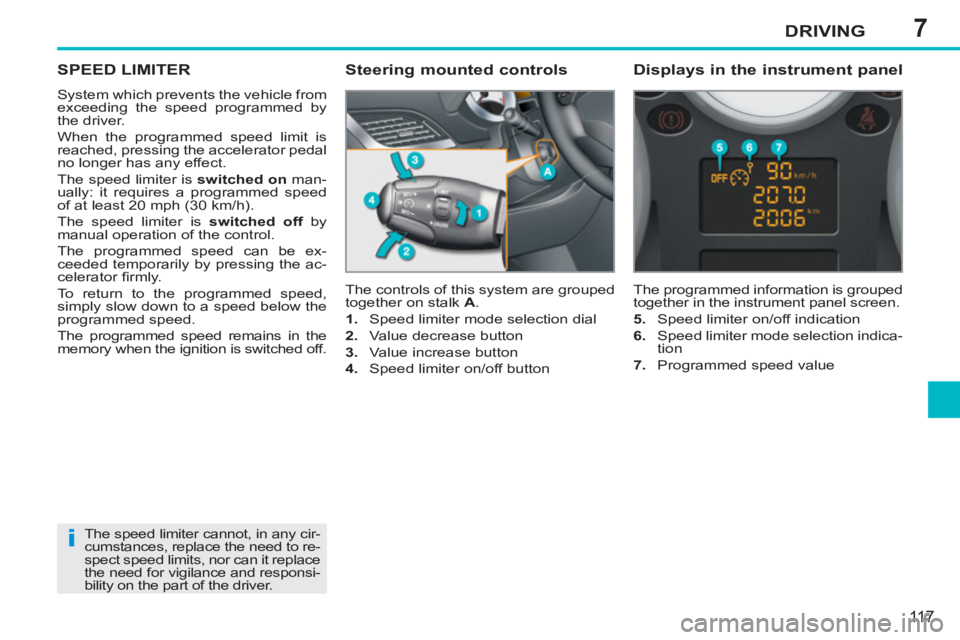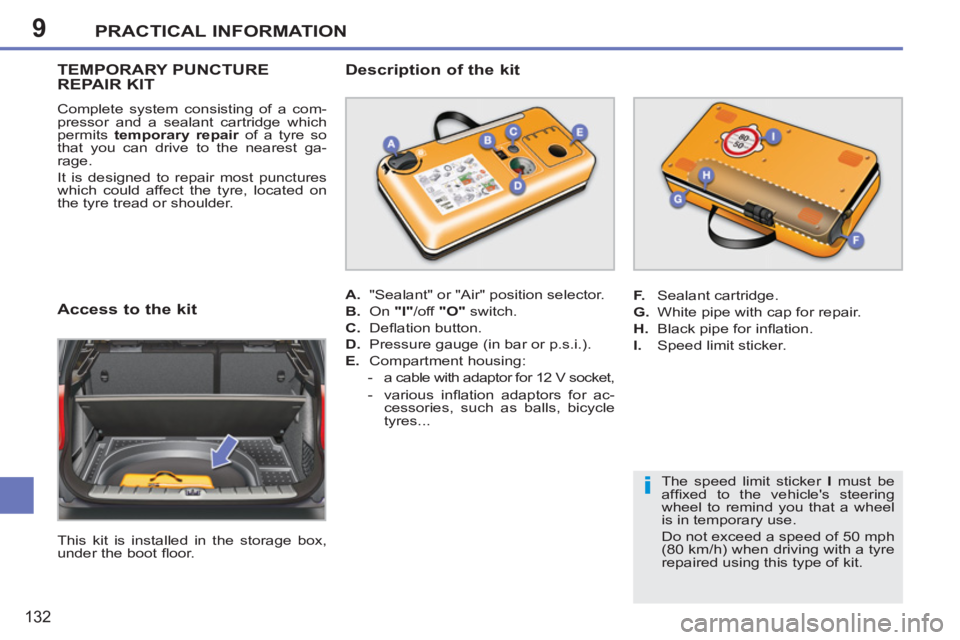2011 PEUGEOT 207 steering
[x] Cancel search: steeringPage 110 of 248

6
i
!
SAFETY
108
AIRBAGS
The airbags do not operate when
the ignition is switched off.
This equipment will only operate
once. If a second impact occurs (dur-
ing the same or a subsequent acci-
dent), the airbag will not operate.
Front airbags
System which protects the head and
chest of the driver and front passenger
in the event of a front impact.
The driver's airbag is fi tted in the centre
of the steering wheel; the front passen-
ger's airbag is fi tted in the dashboard
above the glove box.
Operation
The airbags are deployed simultane-
ously, unless the passenger's front
airbag is deactivated, in the event of a
serious front impact applied to all or part
of the front impact zone A
, in the lon-
gitudinal centreline of the vehicle on a
horizontal plane and directed from the
front to the rear of the vehicle.
The front airbag infl ates between the
front occupant of the vehicle and the
dashboard to cushion their forward
movement.
Impact detection zones
A.
Front impact zone.
B.
Side impact zone.
Deployment of the airbag(s) is ac-
companied by a slight emission of
harmless smoke and a noise, due to
the activation of the pyrotechnic car-
tridge incorporated in the system.
This smoke is not harmful, but sen-
sitive individuals may experience
slight irritation.
The noise of the detonation may
result in a slight loss of hearing for
a short time.
System designed to maximise the safety
of the occupants (with the exception of
the rear centre passenger) in the event
of violent collisions. It supplements the
action of the force-limiting seat belts.
If a collision occurs, the electronic de-
tectors record and analyse the front and
side impacts sustained in the impact
detection zones:
- in the case of a serious impact, the
airbags are deployed instantly and
protect the occupants of the vehicle
(with the exception of the rear centre
passenger); immediately after the
impact, the airbags defl ate rapidly
so that they do not hinder visibility
or the exit of the occupants,
- in the case of a minor or rear impact
or in certain roll-over conditions, the
airbags will not be deployed; the
seat belt alone is suffi cient to pro-
vide optimum protection in these
situations.
Page 113 of 248

6
!
SAFETY
111
Front airbags
Do not drive holding the steering wheel by its spokes or resting your hands on the
centre part of the wheel.
Passengers must not place their feet on the dashboard.
Smoke as little as possible as deployment of the airbags can cause burns or the
risk of injury from a cigarette or pipe.
Never remove or pierce the steering wheel or hit it violently.
Lateral airbags *
Only put approved covers on the seats, compatible with deployment of the lateral air-
bags. To see the range of compatible seat covers for your vehicle, visit a PEUGEOT
dealer (see "Practical information § Accessories").
Do not fi x or attach anything to the seat backs. This could cause injury to the chest
or arms when the lateral airbag infl ates.
Do not sit with the upper part of the body any nearer to the door than necessary.
Curtain airbags *
Do not fi x or attach anything to the roof. This could cause injury to the head when
the curtain airbag infl ates.
Do not remove the grab handles installed on the roof, they play a part in securing
the curtain airbags.
For the airbags to be fully
effective, observe the following
safety rules:
Sit in a normal upright position.
Wear a correctly adjusted seat belt.
Do not leave anything between the
occupants and the airbags (a child,
pet, object...). This could hamper
the operation of the airbags or in-
jure the occupants.
After an accident or if the vehicle
has been stolen or broken into,
have the airbag systems checked.
All work on the airbag system must
be carried out by a PEUGEOT deal-
er or a qualifi ed workshop.
Even if all of the precautions men-
tioned above are observed, a risk of
injury or of slight burns to the head,
chest or arms when an airbag is de-
ployed cannot be ruled out. In fact,
the bag infl ates almost instantly
(within a few milliseconds) then
defl ates within the same time dis-
charging hot gas via the openings
provided for this purpose.
*
According to country.
Page 119 of 248

7
i
DRIVING
11 7
SPEED LIMITER
System which prevents the vehicle from
exceeding the speed programmed by
the driver.
When the programmed speed limit is
reached, pressing the accelerator pedal
no longer has any effect.
The speed limiter is switched on
man-
ually: it requires a programmed speed
of at least 20 mph (30 km/h).
The speed limiter is switched off
by
manual operation of the control.
The programmed speed can be ex-
ceeded temporarily by pressing the ac-
celerator fi rmly.
To return to the programmed speed,
simply slow down to a speed below the
programmed speed.
The programmed speed remains in the
memory when the ignition is switched off. The controls of this system are grouped
together on stalk A
.
1.
Speed limiter mode selection dial
2.
Value decrease button
3.
Value increase button
4.
Speed limiter on/off button
The programmed information is grouped
together in the instrument panel screen.
5. Speed limiter on/off indication
6. Speed limiter mode selection indica-
tion
7. Programmed speed value
Steering mounted controls
Displays in the instrument panel
The speed limiter cannot, in any cir-
cumstances, replace the need to re-
spect speed limits, nor can it replace
the need for vigilance and responsi-
bility on the part of the driver.
Page 121 of 248

7
i
DRIVING
119
CRUISE CONTROL
System which automatically maintains
the speed of the vehicle at the value
programmed by the driver, without any
action on the accelerator pedal.
The cruise control is switched on
manually: it requires a minimum vehicle
speed of 25 mph (40 km/h), as well as
the engaging of:
- fourth gear on a manual gearbox,
- second gear on an automatic gear-
box in sequential mode,
- position D
on an automatic gear-
box.
The cruise control is switched off
man-
ually or by pressing the brake or clutch
pedal or on triggering of the ESP sys-
tem for safety reasons.
It is possible to exceed the programmed
speed temporarily by pressing the ac-
celerator pedal.
To return to the programmed speed,
simply release the accelerator pedal.
Switching off the ignition cancels any
programmed speed value. The controls of this system are grouped
together on stalk A
.
1.
Cruise control mode selection dial
2.
Value decrease button
3.
Value increase button
4.
Cruise control off/resume button
The programmed information is
grouped together in the instrument pan-
el screen.
5.
Cruise control off/resume indication
6.
Cruise control mode selection indi-
cation
7.
Programmed speed value
Steering mounted controls
Displays in the instrument panel
The cruise control cannot, in any cir-
cumstances, replace the need to re-
spect speed limits, nor can it replace
the need for vigilance and responsi-
bility on the part of the driver.
You are advised to keep your feet
near the pedals at all times.
Page 134 of 248

9
i
PRACTICAL INFORMATION
132
TEMPORARY PUNCTURE REPAIR KIT
Complete system consisting of a com-
pressor and a sealant cartridge which
permits temporary repair
of a tyre so
that you can drive to the nearest ga-
rage.
It is designed to repair most punctures
which could affect the tyre, located on
the tyre tread or shoulder.
Access to the kit
This kit is installed in the storage box,
under the boot fl oor.
Description of the kit
A.
"Sealant" or "Air" position selector.
B.
On "I"
/off "O"
switch.
C.
Defl ation button.
D.
Pressure gauge (in bar or p.s.i.).
E.
Compartment housing:
- a cable with adaptor for 12 V socket,
- various infl ation adaptors for ac-
cessories, such as balls, bicycle
tyres...
F.
Sealant cartridge.
G.
White pipe with cap for repair.
H.
Black pipe for infl ation.
I.
Speed limit sticker.
The speed limit sticker I
must be
affi xed to the vehicle's steering
wheel to remind you that a wheel
is in temporary use.
Do not exceed a speed of 50 mph
(80 km/h) when driving with a tyre
repaired using this type of kit.
Page 151 of 248

9PRACTICAL INFORMATION
149
Dashboard fuses
The fusebox is placed in the lower dash-
board (left-hand side).
Access to the fuses
�)
refer to the "Access to the tools"
paragraph.
Fuse tables
Fuse N°
Rating
Functions
G39
20 A
Not used.
G40
20 A
Driver and passenger heated seats.
Fuse N°
Rating
Functions
F1
15 A
Rear wiper.
F2
-
Not used.
F3
5 A
Airbags and pre-tensioners control unit.
F4
10 A
Clutch pedal switch, diagnostic socket,
electrochromatic rear view mirror, air conditioning,
steering wheel angle sensor, particle emission fi lter
pump (Diesel).
F5
30 A
Electric windows, rear one-touch electric windows,
panoramic sunroof (SW).
F6
30 A
Front one-touch electric windows, folding mirrors
supply.
F7
5 A
Front and rear courtesy lamps, map reading lamps,
sun visor lighting, glove box lighting.
Page 152 of 248

9PRACTICAL INFORMATION
150
Fuse N°
Rating
Functions
F8
20 A
Audio equipment, audio/telephone, multifunction
screen, clock, steering wheel controls, trailer
fusebox.
F9
30 A
Front 12 V socket, rear 12 V socket (SW).
F10
15 A
Not used.
F11
15 A
Diagnostic socket, low current ignition switch,
automatic gearbox control unit.
F12
15 A
Rain/sunshine sensor, amplifi er, trailer fusebox,
driving school module.
F13
5 A
Engine fusebox, ABS relay, dual-function brake
switch.
F14
15 A
Instrument panel, seat belt warning lamps panel,
headlamp adjustment, air conditioning, Bluetooth
system, rear parking sensors control unit, airbags.
F15
30 A
Locking.
F17
40 A
Heated rear screen and door mirrors.
SH
-
PARC shunt.
Page 153 of 248

9PRACTICAL INFORMATION
151
Engine compartment fuses
The fusebox is placed in the engine
compartment, near the battery (left-
hand side).
Access to the fuses
�)
Unclip the cover.
�)
Replace the fuse (refer to the cor-
responding paragraph).
�)
When you have fi nished, carefully
close the cover carefully to ensure
correct sealing of the fusebox.
Fuse table
Fuse N°
Rating
Functions
F1
20 A
Engine control unit and fan assembly control relay
supply, timing and canister electrovalves (1.6 litre
16V THP), air fl ow sensor (Diesel), injection pump
(Diesel), water in diesel sensor (Diesel), EGR
electrovalves, air heating (Diesel).
F2
15 A
Horn.
F3
10 A
Front and rear screenwash.
F4
20 A
Headlamp wash.
F5
15 A
Fuel pump (petrol), Turbo electrovalves (1.6 l 16V
THP).
F6
10 A
Vehicle speed sensor, automatic gearbox.
F7
10 A
Electric power steering, switching and protection
unit (Diesel).
F8
25 A
Starter motor control.
F9
10 A
ABS/ESP control unit, brake pedal switch.
F10
30 A
Engine control unit actuators (petrol: ignition coils,
electrovalves, oxygen sensors, injectors, heaters,
electronic thermostat) (Diesel: electrovalves,
heaters).
F11
40 A
Air conditioning blower.
F12
30 A
Windscreen wipers Low/High speed.